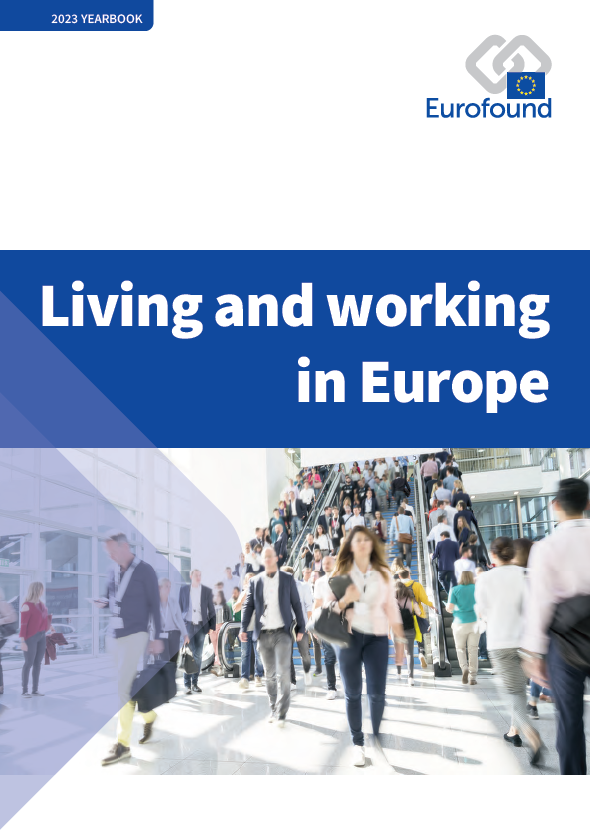
The post-pandemic recovery of Europe continued in 2023, with strong job creation despite subdued economic growth, against a background of rising geopolitical tension. Eurofound’s research over the year brought to light evidence on the key issues shaping the daily lives and work of Europeans. This 2023 yearbook provides a snapshot of that work, summarising the Agency’s findings on a wide range of topics, including rising labour shortages and initiatives to address them, the impact of workplace stressors on health and well-being, the challenges of securing affordable housing, and developments in minimum wages across the Member States. Eurofound’s research on working and living conditions in Europe provides a bedrock of evidence for social policymaking and achieving the Agency’s vision ‘to be Europe’s leading knowledge source for better life and work’.
 Explore the Living and working in Europe digital story
Explore the Living and working in Europe digital story
The report contains the following lists of tables and figures.
List of tables
Table 1: Year-on-year change in employment, by age group and sex, EU27, 2019–2022 (%)
Table 2: Unsocial working hours, by sector and occupation, EU27, 2021 (% of employees)
Table 3: High work intensity, by sector and occupation, EU27, 2021 (% of employees)
Table 4: Financial worries, by sector and occupation, EU27, 2021 (% of employees)
Table 5: Employees with hybrid work arrangements, by sector and occupation, EU27, 2021 (%)
Table 6: Employees who work exclusively from their employer’s premises, by sector and occupation, EU27, 2021 (%)
Table 7: Member States with a pronounced improvement or decline in industrial democracy subdimensions
List of figures
Figure 1: Year-on-year change in employment by sex, EU27, 2019–2022 (%)
Figure 2: Change in baseline scenario employment resulting from Fit for 55, EU Member States, 2030
Figure 4: Employment shifts, by job–wage quintile, 2011–2019 (millions)
Figure 10: Job stressors and resources
Figure 11: Unsocial working hours and subindicators, EU27, 2021 (% of employees)
Figure 13: Scores on health and well-being outcomes for three common stressors
Figure 14: Job quality in 11 essential worker categories, EU27, 2021 (%)
Figure 18: Experiencing work–life interference, by telework category, EU27, 2021 (% of employees)
Figure 19: Reasons for responding to out-of-hours contact from work, 2022 (%)
Figure 20: Perceived impact of being contacted out of hours on health and well-being (%)
Figure 21: Minimum wage increases, EU Member States, 2023 (%)
Figure 22: Change in real minimum wages, EU Member States, 2022–2023 (%)
Figure 23: Hourly nominal minimum wages, EU Member States, January 2023 (€)
Figure 24: Trends in nominal and real wages, euro zone, Q2 2020–Q1 2023
Figure 25: Ranking of Member States on industrial democracy and index subdimensions, 2021
Figure 26: Convergence and divergence patterns in industrial democracy, EU Member States, 2008–2021
Figure 27: Tertiary educational attainment, by Member State and degree of urbanisation, 2021 (%)
Figure 29: Trust in government and trust in the EU, by degree of urbanisation, EU27, 2022
Figure 30: Individual and community recognition gap, by degree of urbanisation, EU27, 2022 (%)
Figure 31: Breakdown of population by type of tenure, EU Member States, 2022 (%)
Figure 32: Rent, house prices, interest rate and disposable income, EU27, 2005–2023
Figure 33: Housing costs, EU Member States, 2019 (monthly purchasing power standard)
Figure 42: Share of households experiencing noise pollution, EU Member States, 2020 (%)
- Number of pages
-
78
- Reference nº
-
EF24002
- ISBN
-
978-92-897-2399-2
- Catalogue nº
-
TJ-AM-24-001-EN-N
- DOI
-
10.2806/49049
- Permalink
Cite this publication
Eurofound (2024), Living and working in Europe 2023, Publications Office of the European Union, Luxembourg.